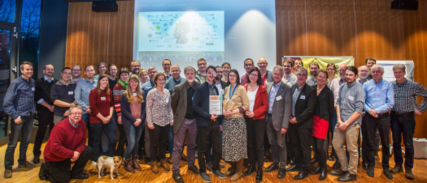Summary
The fourth workshop of the sMon project took place from 13 - 17 January 2020. With over 50 participants, this was the largest workshop of the project so far.
The success of sMon was also shown by the fact that Dr. Andreas Krüss (Head of the Department of Ecology and Protection of Fauna and Flora; BfN) presented the project with the award "Project of the UN Decade of Biodiversity".
The workshop focused on the new taxon groups of carabids and fishes, and experts on the species groups of wild bees and spiders were also present. A further focus was to assess the availability and quality of data sets on possible drivers of observed changes in biodiversity. Furthermore, it was of interest for all participants to find out which tools can be made available to the sMon participants to visualize the observed trends in a comprehensible way and to show spatio-temporal gaps in the available data sets.
A total of 26 presentations (see below) was held on the above topics and group works were carried out in several small groups.
The potential of available distribution data on ground beetles and other coleoptera was evaluated and already some first analyses were carried out.
Species data on fish (e.g.. from the Fish Atlas of Germany and Austria; also data from WFD surveys of the State of Hamburg) also found to be an extremely valuable data treasure. The work required to make these data available throughout Germany is an worthwhile effort, as indicated by analyses of the data from Hamburg.
It became apparent that comprehensive retrospective data sets for driver analysis in Germany are rather difficult to match with the available species data.
So far, it seems that future data sets (e.g. from remote sensing, but also data specifically collected in-situ) are necessary to improve our understanding of the causes of changes in German biodiversity.
Furthermore, the very constructive discussions between the taxonomic experts of different species groups showed very clearly that an intersection of species data across species groups will be an exciting and worthwhile approach for future analyses in the sMon project.
Presentations (mostly in German)
01 Begrüßung durch das sMon Team (Aletta Bonn et al., iDiv)
02 Zusammenfassung der bisherigen sMon Ergebnisse (Dr. D Eichenberg, iDiv)
04 Die Spinnen Deutschlands: Verbreitung und Trends (Hubert Höfer, AraGes)
05 Die Relevanz von Wildbienen in Deutschland (Anne-Christine Mupepele, Uni Freiburg)
06 Amphibien in Deutschland: Stand der bisherigen Analysen (Klaus Henle, UFZ)
13 InsektenMobil Deutschland: Ein Citizen-Science Projekt (Susanne Hecker; iDiv)
14 MonViA - Monitoring der biologischen Vielfalt in Agrarlandschaften in Deutschland (Petra Dieker; Thünen Institut)
15 All-EMA Biodiversitätsmonitoring der Agrarlandschaften in der Schweiz (Susanne Riedel, Agroscope)
16 BienABest - eine aktuelle Bilanz des deutschlandweiten Wildbienenmonitorings (Hannah Burger, VdI)
17 Ausblick zum Nationalen Biodiversitätsmonitoring Deutschland (Wiebke Züghart, BfN)
19 Anthropogene Gefährdungsfaktoren der Biodiversität auf globaler Ebene (Diana Bowler, iDiv)
20 Taxon-übergreifende Biodiversitätstrends in Zentraleuropa (Eva Katharina Engelhardt, TUM)
21 Überblick über mögliche Treiberdaten des LLUR (Silke Lütt/Simon Kellner, LLUR Schleswig-Holstein)
22 Satellitengestütztes Monitoring von Heckenstrukturen in Bayern (Samuel Rauhut, LfU Bayern)
23 Vorschläge zur standardisierten Weiterführung historischer Arterfassungen am Beispiel der
Herpetofauna in Sachsen (Holger Lueg, LfULG)
24 Struktur, Inhalt und Verfügbarkeit des InVeKos Datensatzes (Norbert Röder, Thünen Institut)
25 Treiberdaten aus dem Bereich der genutzten Landschaften (Michael Beckmann, UfZ)

